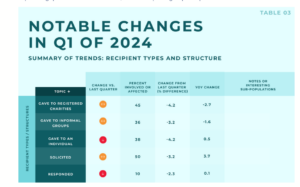Giving Flat For Q1 of 2024, More Give Locally

Giving hit its annual trough during mid-February, with all forms of giving declining except volunteering, which dropped to low levels in December and early January then gradually increased throughout February. However, there was an associated drop in the percentage of people who were solicited.
In general, though, all forms of generosity held steady during the first quarter of 2024, including the percentage of people giving monetary donations. Giving methods (cash and other generosity) were similar to the fourth quarter of 2023, plus or minus 2%. There was also a slight turn to give more locally.
That is some of the data released in the new quarterly “GivingPulse” report from GivingTuesday. The lull during February might be a case of simply not asking for a gift.
“We think it does illustrate this point well. People appear to be ready and willing to give when they are engaged, and we think there are year-long opportunities with different donor segments,” said Woodrow Rosenbaum, chief data officer for GivingTuesday. All respondents are asked about when they were most recently solicited, and researchers generally consider an individual as recently solicited if they have been approached during the past week or month, depending on the analysis. All respondents were are asked about their recent giving behaviors regardless of whether they were recently solicited or not, according to Rosenbaum.

Data show that income and financial strain appear to have limited influence over someone’s likelihood to respond to a solicitation, so the issue is why nonprofits not asking everyone. “We think this is a good question the sector should be asking itself. We have, for too long, been hyper-focused on large donor stewardship at the expense of broad engagement,” said Rosenbaum. GivingPulse data provides “new evidence that there is a substantial missed opportunity. Beyond the money that could be raised, we also think it’s important for the social sector to be supported by a much more diverse and democratic donor base,” he explained.
It is projected that an additional 7% of respondents would have reacted generously to solicitation if they had been asked. “This group represents an untapped generosity market that is ready to give more if asked more frequently, but also highlights the need for increased engagement of the large number of unsolicited individuals who still may not respond generously if asked,” Rosembaum said.
The percentage of people supporting international organizations increased slightly in February before declining back to levels seen at the beginning of the quarter during March. The increase corresponded with a relative decline in support for national organizations during the same period. “Our feeling is that people are looking for ways to belong in their communities – and the social sector offers tremendous opportunities to help people nurture that sense of generosity and to have agency to make meaningful change,” said Rosenbaum.
Respondents were asked whether their most recent form of generosity was intended to help others in their own community, within the same country or outside of their country. The proportion of people targeting their generosity locally, nationally or internationally is relatively stable, at 65%, 28% and 9% respectively. These percentages typically varied by plus or minus 5% during all of 2023, except during the start of the Israel-Hamas war when international giving doubled from 8% to 17%.
While crisis awareness remained stable this quarter, response to crises dropped from 31% to 22%, a decline of nearly 30%. The shift appears to be toward ignoring crises, which increased in popularity overall and among solicited people asked in the past week or past month, those who pre-planned their giving, and those who gave spontaneously, the data shows. In fact, there are very few subgroups for which response to crises remained stable or increased between the fourth quarter of 2023 and the first quarter of 2024.
Respondents younger than 25, those ignoring a recent solicitation, and those reporting awareness of the Israel-Hamas war are three of the only subgroups of respondents whose crisis response rate was similar to or greater than in the fourth quarter of 2023, the data showed.
For the complete report, go to https://www.givingpulse.givingtuesday.org/q12024
The post Giving Flat For Q1 of 2024, More Give Locally appeared first on The NonProfit Times.









Leave a Reply